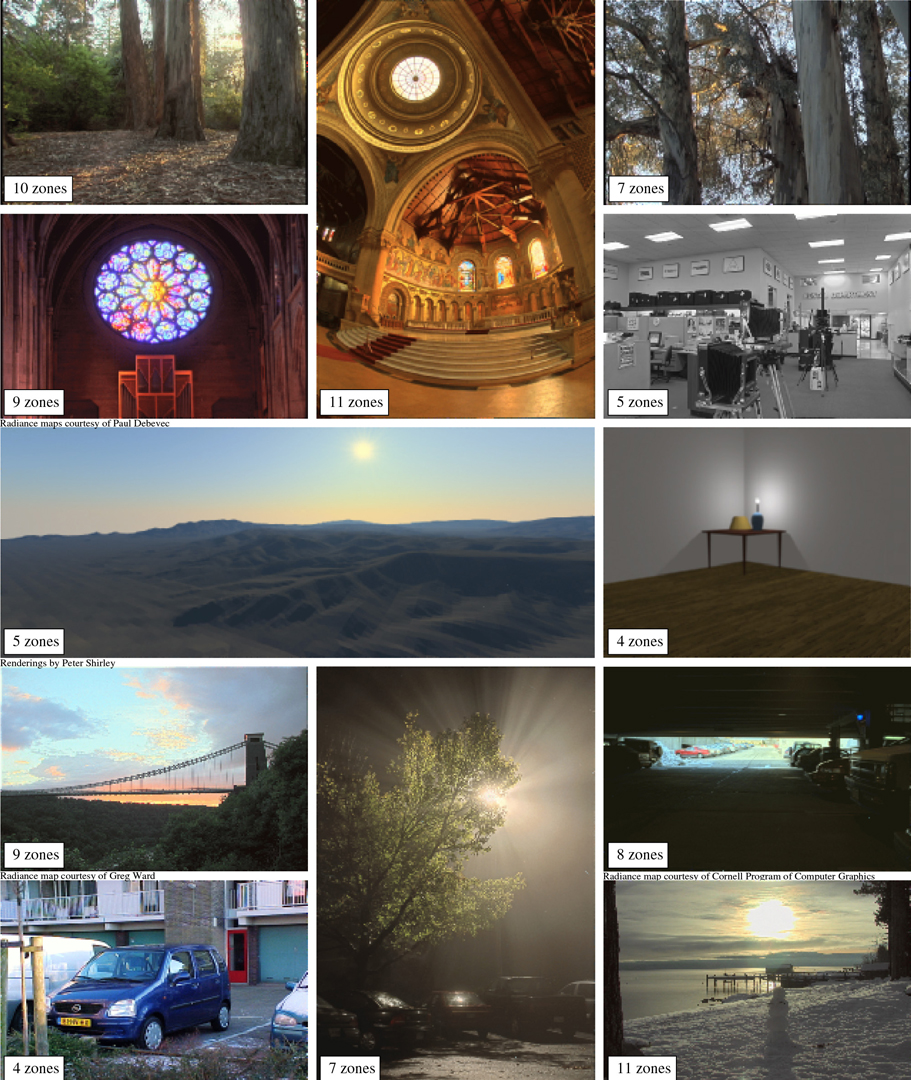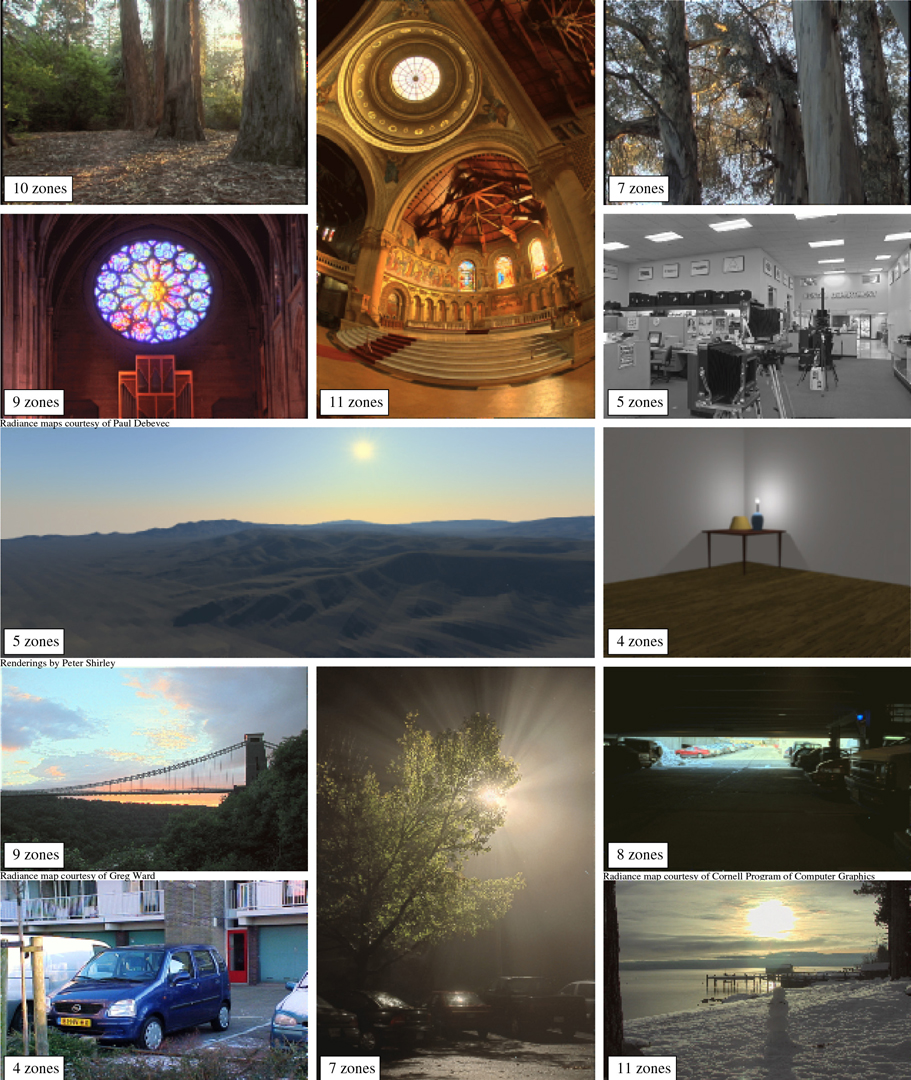“Photographic tone reproduction for digital images”
Conference:
Type(s):
Title:
- Photographic tone reproduction for digital images
Presenter(s)/Author(s):
Abstract:
A classic photographic task is the mapping of the potentially high dynamic range of real world luminances to the low dynamic range of the photographic print. This tone reproduction problem is also faced by computer graphics practitioners who map digital images to a low dynamic range print or screen. The work presented in this paper leverages the time-tested techniques of photographic practice to develop a new tone reproduction operator. In particular, we use and extend the techniques developed by Ansel Adams to deal with digital images. The resulting algorithm is simple and produces good results for a wide variety of images.
References:
1. ADAMS, A. 1980. The camera. The Ansel Adams Photography series. Little, Brown and Company.Google Scholar
2. ADAMS, A. 1981. The negative. The Ansel Adams Photography series. Little, Brown and Company.Google Scholar
3. ADAMS, A. 1983. The print. The Ansel Adams Photography series. Little, Brown and Company.Google Scholar
4. BLOMMAERT, F. J. J., AND MARTENS, J.-B. 1990. An object-oriented model for brightness perception. Spatial Vision 5, 1, 15-41.Google Scholar
5. BURT, P. J., AND ADELSON, E. H. 1983. A multiresolution spline with application to image mosaics. ACM Transactions on Graphics 2, 4, 217-236. Google Scholar
6. CHIU, K., HERF, M., SHIRLEY, P., SWAMY, S., WANG, C., AND ZIMMERMAN, K. 1993. Spatially nonuniform scaling functions for high contrast images. In Proceedings of Graphics Interface ’93, 245-253.Google Scholar
7. COHEN, J., TCHOU, C., HAWKINS, T., AND DEBEVEC, P. 2001. Real-Time high dynamic range texture mapping. In Rendering techniques 2001, S. J. Gortler and K. Myszkowski, Eds., 313-320. Google Scholar
8. DEBEVEC, P. E., AND MALIK, J. 1997. Recovering high dynamic range radiance maps from photographs. In SIGGRAPH 97 Conference Proceedings, Addison Wesley, T. Whitted, Ed., Annual Conference Series, ACM SIGGRAPH, 369-378. Google Scholar
9. DURAND, F., AND DORSEY, J. 2000. Interactive tone mapping. In Eurographics Workshop on Rendering, 219-230. Google Scholar
10. FAIRCHILD, M. D. 1998. Color appearance models. Addison-Wesley, Reading, MA.Google Scholar
11. FERWERDA, J. A., PATTANAIK, S., SHIRLEY, P., AND GREENBERG, D. P. 1996. A model of visual adaptation for realistic image synthesis. In SIGGRAPH 96 Conference Proceedings, Addison Wesley, H. Rushmeier, Ed., Annual Conference Series, ACM SIGGRAPH, 249-258. Google Scholar
12. GEIGEL, J., AND MUSGRAVE, F. K. 1997. A model for simulating the photographic development process on digital images. In SIGGRAPH 97 Conference Proceedings, Addison Wesley, T. Whitted, Ed., Annual Conference Series, ACM SIGGRAPH, 135-142. Google Scholar
13. GOVE, A., GROSSBERG, S., AND MINGOLLA, E. 1995. Brightness perception, illusory contours, and corticogeniculate feedback. Visual Neuroscience 12, 1027-1052.Google Scholar
14. GRAVES, C. 1997. The zone system for 35mm photographers, second ed. Focal Press.Google Scholar
15. HANSEN, T., BARATOFF, G., AND NEUMANN, H. 2000. A simple cell model with dominating opponent inhibition for robust contrast detection. Kognitionswissenschaft 9, 93-100. Google Scholar
16. HOLM, J. 1996. Photographics tone and colour reproduction goals. In CIE Expert Symposium ’96 on Colour Standards for Image Technology, 51-56.Google Scholar
17. JERNIGAN, M. E., AND MCLEAN, G. F. 1992. Lateral inhibition and image processing. In Non-linear vision: determination of neural receptive fields, function, and networks, R. B. Pinter and B. Nabet, Eds. CRC Press, ch. 17, 451-462.Google Scholar
18. JOHNSON, C. 1999. The practical zone system. Focal Press.Google Scholar
19. LAND, E. H., AND MCCANN, J. J. 1971. Lightness and retinex theory. J. Opt. Soc. Am. 63, 1, 1-11.Google Scholar
20. LONDON, B., AND UPTON, J. 1998. Photography, sixth ed. Longman.Google Scholar
21. MARR, D., AND HILDRETH, E. C. 1980. Theory of edge detection. Proceedings of the Royal Society of London, B 207, 187-217.Google Scholar
22. MARR, D. 1982. Vision, a computational investigation into the human representation and processing of visual information. W H Freeman and Company, San Fransisco. Google Scholar
23. MATKOVIC, K., NEUMANN, L., AND PURGATHOFER, W. 1997. A survey of tone mapping techniques. In 13th Spring Conference on Computer Graphics, W. Straßer, Ed., 163-170.Google Scholar
24. MCNAMARA, A., CHALMERS, A., AND TROSCIANKO, T. 2000. STAR: Visual perception in realistic image synthesis. In Eurographics 2000 STAR reports, Eurographics, Interlaken, Switzerland.Google Scholar
25. MCNAMARA, A. 2001. Visual perception in realistic image synthesis. Computer Graphics Forum 20, 4 (December), 211-224.Google Scholar
26. MILLER, N. J., NGAI, P. Y., AND MILLER, D. D. 1984. The application of computer graphics in lighting design. Journal of the IES 14 (October), 6-26.Google Scholar
27. MITCHELL, E. N. 1984. Photographic Science. John Wiley and Sons, New York.Google Scholar
28. OPPENHEIM, A. V., SCHAFER, R., AND STOCKHAM, T. 1968. Nonlinear filtering of multiplied and convolved signals. Proceedings of the IEEE 56, 8, 1264-1291.Google Scholar
29. PARDO, A., AND SAPIRO, G. 2001. Visualization of high dynamic range images. Tech. Rep. 1753, Institute for Mathematics and its Applications, University of Minnesota.Google Scholar
30. PATTANAIK, S. N., FERWERDA, J. A., FAIRCHILD, M. D., AND GREENBERG, D. P. 1998. A multiscale model of adaptation and spatial vision for realistic image display. In SIGGRAPH 98 Conference Proceedings, Addison Wesley, M. Cohen, Ed., Annual Conference Series, ACM SIGGRAPH, 287-298. Google Scholar
31. PATTANAIK, S. N., TUMBLIN, J., YEE, H., , AND GREENBERG, D. P. 2000. Time-dependent visual adaptation for fast realistic display. In SIGGRAPH 2000 Conference Proceedings, Addison Wesley, K. Akeley, Ed., Annual Conference Series, ACM SIGGRAPH, 47-54. Google Scholar
32. PELI, E. 1990. Contrast in complex images. J. Opt. Soc. Am. A 7, 10 (October), 2032-2040.Google Scholar
33. PESSOA, L., MINGOLLA, E., AND NEUMANN, H. 1995. A contrast- and luminance-driven multiscale network model of brightness perception. Vision Research 35, 15, 2201-2223.Google Scholar
34. RAHMAN, Z., JOBSON, D. J., AND WOODELL, G. A. 1996. A multiscale retinex for color rendition and dynamic range compression. In SPIE Proceedings: Applications of Digital Image Processing XIX, vol. 2847.Google Scholar
35. RAHMAN, Z., WOODELL, G. A., AND JOBSON, D. J. 1997. A comparison of the multiscale retinex with other image enhancement techniques. In IS&T’s 50th Annual Conference: A Celebration of All Imaging, vol. 50, 426-431.Google Scholar
36. REINHARD, E., ASHIKHMIN, M., GOOCH, B., AND SHIRLEY, P. 2001. Color transfer between images. IEEE Computer Graphics and Applications 21 (September/October), 34-41. Google Scholar
37. SCHEEL, A., STAMMINGER, M., AND SEIDEL, H.-P. 2000. Tone reproduction for interactive walkthroughs. Computer Graphics Forum 19, 3 (August), 301-312.Google Scholar
38. SCHLICK, C. 1994. Quantization techniques for the visualization of high dynamic range pictures. In Photorealistic Rendering Techniques, Springer-Verlag Berlin Heidelberg New York, P. Shirley, G. Sakas, and S. Müller, Eds., 7-20.Google Scholar
39. STOCKHAM, T. 1972. Image processing in the context of a visual model. Proceedings of the IEEE 60, 7, 828-842.Google Scholar
40. STROEBEL, L., COMPTON, J., CURRENT, I., AND ZAKIA, R. 2000. Basic photographic materials and processes, second ed. Focal Press.Google Scholar
41. TUMBLIN, J., AND RUSHMEIER, H. 1991. Tone reproduction for realistic computer generated images. Tech. Rep. GIT-GVU-91-13, Graphics, Visualization, and Useability Center, Georgia Institute of Technology.Google Scholar
42. TUMBLIN, J., AND RUSHMEIER, H. 1993. Tone reproduction for computer generated images. IEEE Computer Graphics and Applications 13, 6 (November), 42-48. Google Scholar
43. TUMBLIN, J., AND TURK, G. 1999. LCIS: A boundary hierarchy for detail-preserving contrast reduction. In Siggraph 1999, Computer Graphics Proceedings, Addison Wesley Longman, Los Angeles, A. Rockwood, Ed., Annual Conference Series, 83-90. Google Scholar
44. TUMBLIN, J., HODGINS, J. K., AND GUENTER, B. K. 1999. Two methods for display of high contrast images. ACM Transactions on Graphics 18 (1), 56-94. Google Scholar
45. UPSTILL, S. 1985. The Realistic Presentation of Synthetic Images: Image Processing in Computer Graphics. PhD thesis, University of California at Berkeley. Google Scholar
46. WARD, G., RUSHMEIER, H., AND PIATKO, C. 1997. A visibility matching tone reproduction operator for high dynamic range scenes. IEEE Transactions on Visualization and Computer Graphics 3, 4 (December). Google Scholar
47. WARD LARSON, G., AND SHAKESPEARE, R. A. 1998. Rendering with Radiance. Morgan Kaufmann Publishers.Google Scholar
48. WARD, G. 1994. A contrast-based scalefactor for luminance display. In Graphics Gems IV, P. Heckbert, Ed. Academic Press, Boston, 415-421. Google Scholar
49. WHITE, M., ZAKIA, R., AND LORENZ, P. 1984. The new zone system manual. Morgan & Morgan, Inc.Google Scholar
50. WOODS, J. C. 1993. The zone system craftbook. McGraw Hill.Google Scholar





